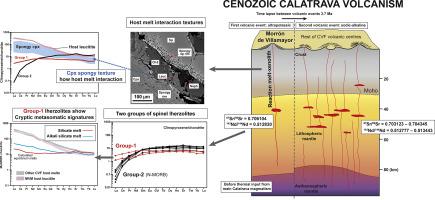Our official English website, www.x-mol.net, welcomes your
feedback! (Note: you will need to create a separate account there.)
Depleted lherzolite xenoliths from the leucititic Morrón de Villamayor volcano (Calatrava volcanic field, Spain)
Lithos ( IF 2.9 ) Pub Date : 2021-01-01 , DOI: 10.1016/j.lithos.2020.105830 Javier García Serrano , Carlos Villaseca , Cecilia Pérez-Soba
Lithos ( IF 2.9 ) Pub Date : 2021-01-01 , DOI: 10.1016/j.lithos.2020.105830 Javier García Serrano , Carlos Villaseca , Cecilia Pérez-Soba

|
Abstract This work reports petrographical, mineralogical and geochemical data of a suite of mantle xenoliths from the Morron de Villamayor volcanic centre (MVM), which belongs to the Calatrava Volcanic Field (CVF), a part of the Circum-Mediterranean Anorogenic Cenozoic Igneous Province. The MVM volcano is the only centre belonging to the first stage of the CVF magmatism, an ultrapotassic stage that provides a sampling of the subcontinental lithospheric mantle beneath central Spain. The MVM peridotites record a variable host melt interaction (spongy texture and reaction zones), more intense toward xenolith-host leucitite contacts that it was formed during transport within the volcanic melt. The studied mantle xenoliths are spinel lherzolites equilibrated at lower temperatures (618–942 °C) and similar pressure ranges (8.8–13.6 kbar) than other studied CVF mantle xenoliths, and record a lithospheric mantle before the main volcanic Calatrava event. The MVM lherzolites could be classified in two groups by their chondrite-normalized rare earth element (REE) clinopyroxene patterns: group-1 lherzolites show flat pattern, and group-2 lherzolites display a LREE-depleted (N-MORB like) pattern. Group-1 lherzolites represent a more residual lithospheric mantle (up to 9 partial melting %) than group-2 lherzolites (~ 5%), the latter with similar partial melting degrees than other mantle xenoliths from the CVF. Moreover, group-1 lherzolites have undergone a post partial melting refertilization by different metasomatic agents: silicate and alkaline silicate melts different in composition to host leucitite. A primary clinopyroxene concentrate from these MVM lherzolites provides high Sr (87Sr/86Sr = 0.706104) and intermediate Nd (143Nd/144Nd = 0.512830) initial radiogenic ratios, not previously recorded in this volcanic field. This sampling proves the presence of an enriched isotope mantle pole in xenolith suites of the Calatrava area, trending in composition to an intermediate DMM-EMII component.
中文翻译:

来自白质质 Morrón de Villamayor 火山(西班牙 Calatrava 火山场)的贫化锂辉石捕虏体
摘要 这项工作报告了来自 Morron de Villamayor 火山中心 (MVM) 的一套地幔包体的岩石学、矿物学和地球化学数据,该火山中心属于 Calatrava 火山区 (CVF),该火山区属于环地中海无造山新生代火成岩省的一部分。MVM 火山是唯一属于 CVF 岩浆活动第一阶段的中心,这是一个超钾化阶段,提供了西班牙中部下方次大陆岩石圈地幔的样本。MVM 橄榄岩记录了一个可变的主体熔体相互作用(海绵质地和反应区),在火山熔体中运输过程中形成的捕虏体-主体白榴石接触更加强烈。研究的地幔捕虏体是在较低温度 (618–942 °C) 和类似压力范围 (8.8–13. 6 kbar) 比其他研究的 CVF 地幔包体,并记录了主要火山 Calatrava 事件之前的岩石圈地幔。根据球粒陨石归一化稀土元素 (REE) 单斜辉石模式,MVM 镁橄榄石可分为两组:第 1 族锂辉石显示平坦模式,第 2 族锂辉石显示出 LREE 耗尽(N-MORB 样)模式。组 1 橄榄石代表了比组 2 橄榄石(~ 5%)更多的残余岩石圈地幔(高达 9 部分熔融 %),后者具有与来自 CVF 的其他地幔包体相似的部分熔融度。此外,第 1 组锂辉石通过不同的交代剂经历了部分熔融后的再肥化:硅酸盐和碱性硅酸盐熔体在成分上与主体白榴石不同。来自这些 MVM 锂辉石的初级斜辉石浓缩物提供了高 Sr (87Sr/86Sr = 0.706104) 和中等 Nd (143Nd/144Nd = 0.512830) 的初始放射成因比率,以前在这个火山场中没有记录。该采样证明在 Calatrava 地区的捕虏体套件中存在富含同位素的地幔极,其成分趋向于中间 DMM-EMII 成分。
更新日期:2021-01-01
中文翻译:

来自白质质 Morrón de Villamayor 火山(西班牙 Calatrava 火山场)的贫化锂辉石捕虏体
摘要 这项工作报告了来自 Morron de Villamayor 火山中心 (MVM) 的一套地幔包体的岩石学、矿物学和地球化学数据,该火山中心属于 Calatrava 火山区 (CVF),该火山区属于环地中海无造山新生代火成岩省的一部分。MVM 火山是唯一属于 CVF 岩浆活动第一阶段的中心,这是一个超钾化阶段,提供了西班牙中部下方次大陆岩石圈地幔的样本。MVM 橄榄岩记录了一个可变的主体熔体相互作用(海绵质地和反应区),在火山熔体中运输过程中形成的捕虏体-主体白榴石接触更加强烈。研究的地幔捕虏体是在较低温度 (618–942 °C) 和类似压力范围 (8.8–13. 6 kbar) 比其他研究的 CVF 地幔包体,并记录了主要火山 Calatrava 事件之前的岩石圈地幔。根据球粒陨石归一化稀土元素 (REE) 单斜辉石模式,MVM 镁橄榄石可分为两组:第 1 族锂辉石显示平坦模式,第 2 族锂辉石显示出 LREE 耗尽(N-MORB 样)模式。组 1 橄榄石代表了比组 2 橄榄石(~ 5%)更多的残余岩石圈地幔(高达 9 部分熔融 %),后者具有与来自 CVF 的其他地幔包体相似的部分熔融度。此外,第 1 组锂辉石通过不同的交代剂经历了部分熔融后的再肥化:硅酸盐和碱性硅酸盐熔体在成分上与主体白榴石不同。来自这些 MVM 锂辉石的初级斜辉石浓缩物提供了高 Sr (87Sr/86Sr = 0.706104) 和中等 Nd (143Nd/144Nd = 0.512830) 的初始放射成因比率,以前在这个火山场中没有记录。该采样证明在 Calatrava 地区的捕虏体套件中存在富含同位素的地幔极,其成分趋向于中间 DMM-EMII 成分。











































 京公网安备 11010802027423号
京公网安备 11010802027423号